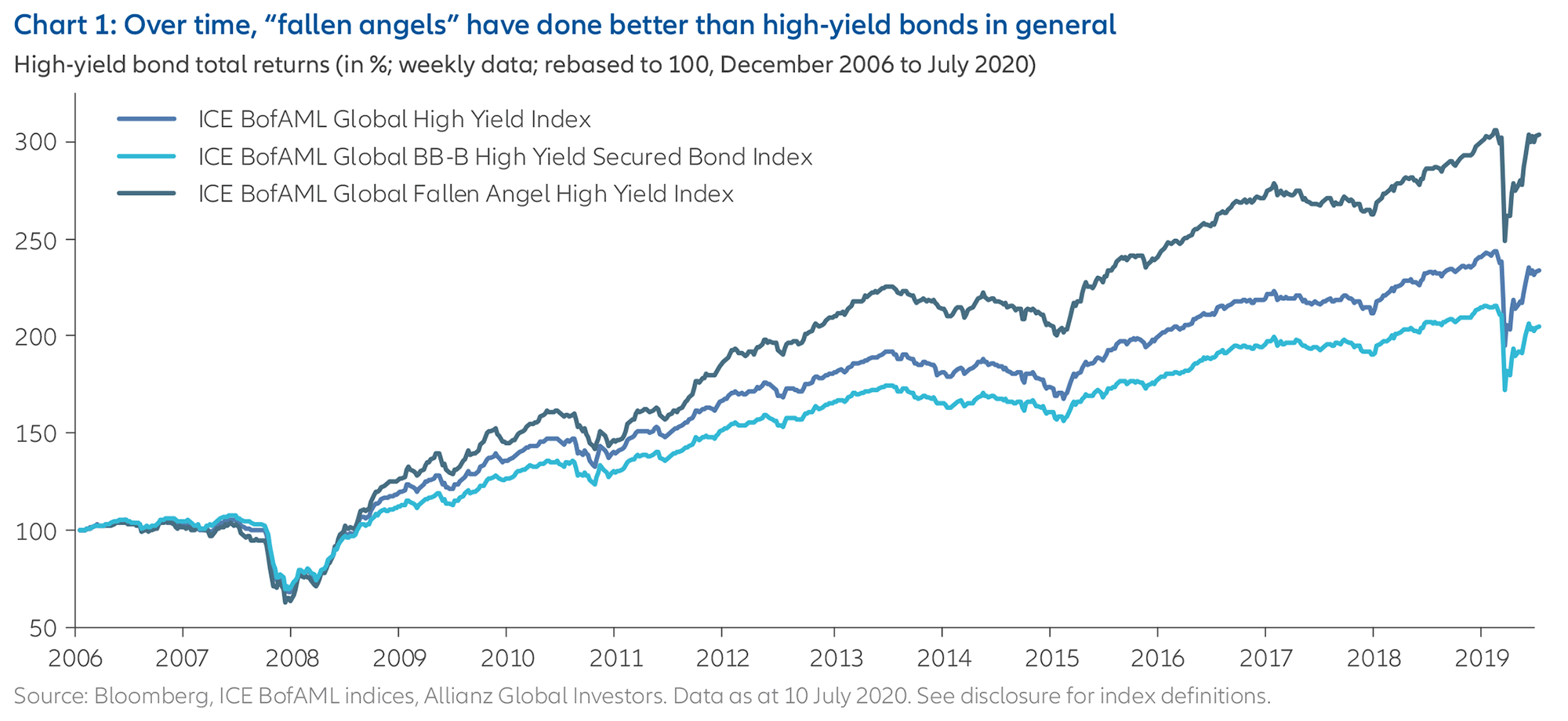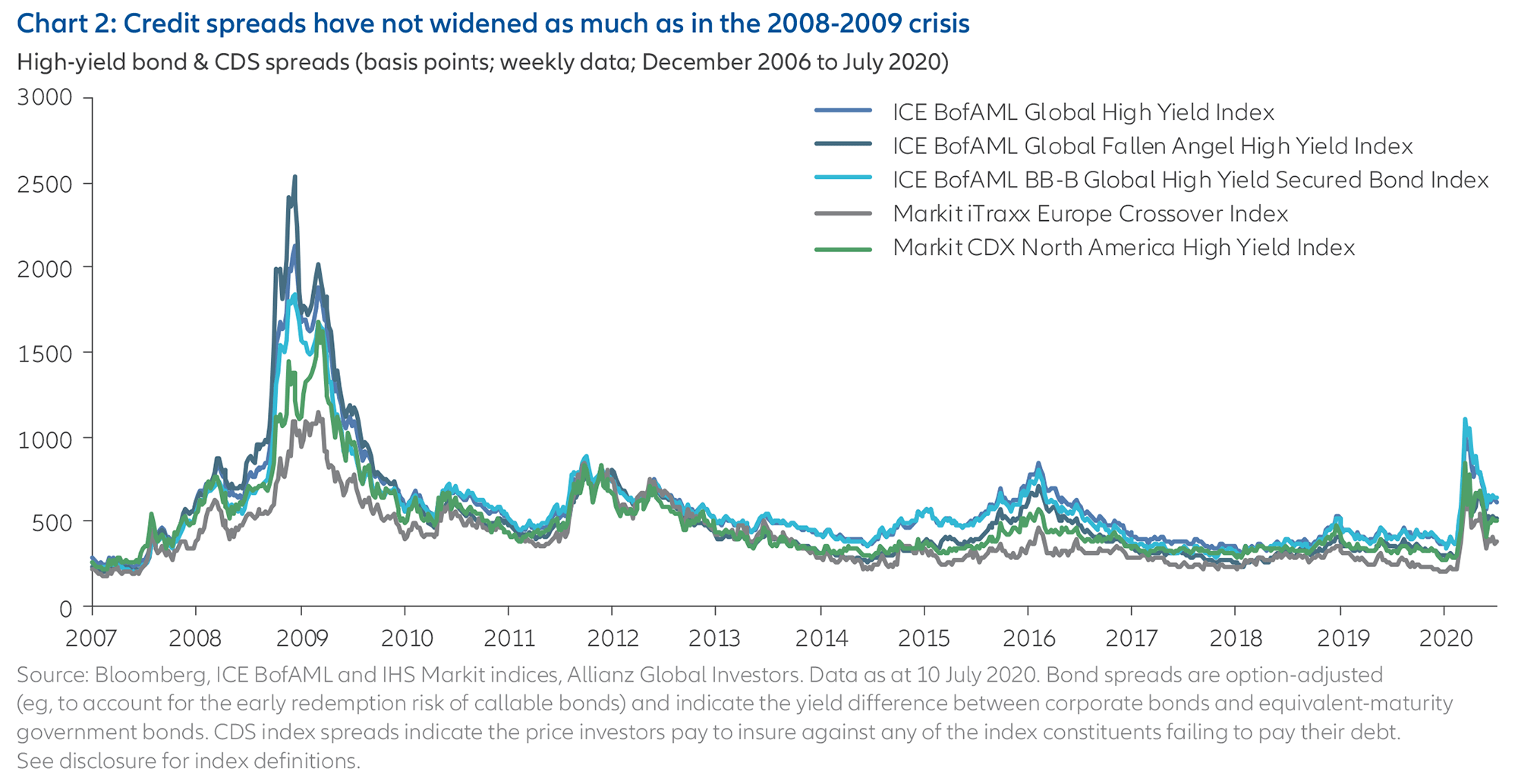Two ways credit can add relative value as the cycle turns

Summary
The risk/reward profile of corporate bonds is less attractive now than when the coronavirus crisis began. Since then, bonds from higher-rated firms have been buoyed by central bank support. As the credit cycle turns, we suggest prioritising both issuer and security selection to seek outperformance – potentially with fallen angels and secured bonds.
Key takeaways
|
According to the Bank for International Settlements, 50% of firms globally may have insufficient cash flows to cover debt-related and operating expenses for 2020. This may push many credit investors higher up the rating spectrum as they seek to avoid potential distress in lower-quality credits. However, such an approach brings two main risks to performance.
- First, many of these higher-rated bonds are already back to trading close to par, or their full value. This means their prices are less likely to appreciate further, so investors may only get returns from the bonds’ coupon payments.
- Second, high-yield investors may run the risk of not earning the full yield-to-maturity because issuers can “call”, or redeem earlier, a large share of bonds to refinance the debt at lower rates.
One possible solution is to invest selectively in so-called “fallen angels” – issuers that have been downgraded to high yield, but which may go on to regain investment-grade status.
Seek out selective and defensive exposure to fallen angels
Fallen angels consist largely of non-callable bonds that may offer relative value, in the sense that they trade at deeper discounts than would be suggested by their credit fundamentals and peers. Historically, fallen angels have outperformed the broader high-yield market, as illustrated in Chart 1.

However, fallen angels in aggregate may not be offering quite as much value as they have in the past. As Chart 2 shows, fallen-angel credit spreads have not widened, or “cheapened”, as much in the current crisis as in 2008-2009, indicating that these issuers may offer less relative value than they did in the past. One possible factor behind this has been the unprecedented move by central banks to buy, or accept as collateral, bonds issued by fallen angels. By pushing up the prices of these bonds, this form of systemic stimulus can mask the remaining risks that are specific to each firm, and it can cap the potential for excess returns from fallen angels as a group. Research shows that only around one quarter of fallen angels make it back to investment grade, so it’s important to take a highly selective approach when investing in these securities.

Moreover, a defensive way to add to or to hedge fallen-angel exposure is through “long” or “short” positions in corporate credit-default swap (CDS) indices. Long positions on these exchange-traded derivatives gain in value when there is an improvement in credit quality in the underlying unsecured bonds (which are insured against default by CDS contracts). CDS indices are relevant because fallen-angel and crossover securities tend to dominate CDS markets more than lower- or higher-rated securities. Also, CDS indices are usually more liquid than cash bonds, which can help CDS outperform as credit conditions improve.
There is value within the secured bonds universe
Secured bonds offer an alternative way to add relative value to credit portfolios, even if the segment may not look that attractive at first glance. Chart 1 shows that secured bonds have underperformed the fallen-angel universe and broader high-yield bond market – which are made up of approximately 5% and 20% of secured debt, respectively.
Intuitively this makes sense. Secured bonds offer greater loss protection, so they should command a lower risk premium. They have seniority over unsecured bonds and are collateralised with company assets and other guarantees – which has historically given them much higher recovery rates (more than 65%) in the event of default. For example, when an issuer is downgraded from a BB to a B rating, its secured bonds can trade at credit (risk) spreads as much as 200 basis points lower than their unsecured counterparts. Moreover, secured bonds have shorter duration on average, which can help smooth the impact of longer-term volatility in interest rates and spreads.
We think it’s particularly worthwhile to look at secured bonds now because major credit downturns usually prompt companies to pledge various forms of collateral in order to attract financing, potentially making their secured bonds even more attractive. For instance, in 2009, following the global financial crisis, the proportion of new corporate debt accounted for by secured bonds rose by several multiples year-on-year. This credit-cycle downturn has been similar, with April marking a record high so far in the volume of secured bonds issued globally each month.
However, unlike in 2009, credit spreads today more closely resemble those of the broader high-yield market. This means that on a loss- or recovery-adjusted basis, there will likely be bargains to be found within the secured bonds universe. This may be because many investors remain cautious, perceiving the increased issuance of secured debt as predominantly a sign of distress. But in a crisis as deep as the current one, healthier issuers are just as likely to issue secured debt as those that go on to default. Experienced credit managers with large research teams can often buy high-quality secured bonds at much higher-than-usual yields, especially in the primary market.
Since March this year, we have seen at least two examples of new secured bond issues that subsequently paid off on a relative value basis.
- One firm with a B rating was under pressure to fund cash needs and refinance bank loans, so it issued new secured bonds at double-digit yields more typical of CCC rated debt.
- Another high-yield issuer needed to pay down existing unsecured bonds that carried higher coupons, so it tapped the primary market with secured bonds that were rated investment-grade but actually yielded more than comparable securities.
Both issuers had at least one common characteristic: they did not issue as much secured debt in good times, leaving unencumbered assets at hand to pledge as collateral in bad times. A healthy loan-to-value ratio – ie, a relatively low level of debt compared to a company’s secured assets – became an important metric to consider when future earnings visibility vanished as economies went into lockdown.
Whether or not the credit rally continues, focus on relatively undervalued assets
Looking ahead, the risk-reward balance in corporate credit remains attractive, even if less so than in the first quarter of 2020. Higher-quality high-yield credit may be more skewed to income than capital gains for now, but we still see significant upside and lower downside in select fallen angels and secured bonds. Focusing on relatively undervalued assets may be more likely to deliver outperformance, whether or not the credit rally continues.
If credit spreads tighten further, identifying value relative to equivalent securities could help enhance returns for investors who feel they have missed out. Alternatively, if a “V-shaped” recovery does not materialise, repeated spread widening should push investors to prioritise liquidity and loss mitigation. Multi-sector and high-yield strategies – with a selective and defensive profile – have the potential to outperform in both scenarios.
Duration is a measure of the sensitivity of the price of a bond to a change in interest rates. ICE BofAML Global High Yield Index tracks the performance of USD, CAD, GBP and EUR denominated below investment grade corporate debt publicly issued in the major domestic or eurobond markets. ICE BofAML Global Fallen Angel High Yield Index is a subset of ICE BofAML Global High Yield Index including securities that were rated investment grade at the point of issuance. ICE BofAML BB-B Global High Yield Secured Bond Index is a subset of ICE BofAML Global High Yield Index including all secured securities rated BB1 through B3, inclusive. The Markit iTraxx Europe Crossover Index comprises 75 equally weighted credit default swaps on the most liquid sub-investment grade European corporate entities. The Markit CDX North America High Yield Index is composed of 100 non-investment grade entities, distributed among 2 sub-indices: B, BB. All entities are domiciled in North America. It is not possible to invest directly in an index.
Why the coming months are critical to a decisive green transition

Summary
As the world battles the Covid-19 pandemic, responsible investors can help make the economic recovery sustainable and inclusive by engaging with the right stakeholders. A PRI working group has developed recommendations for a policy-engagement framework to help guide the investment community’s actions. Here are highlights of the group’s findings.
Key takeaways
|





